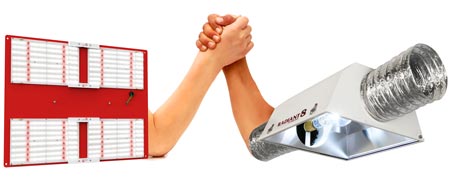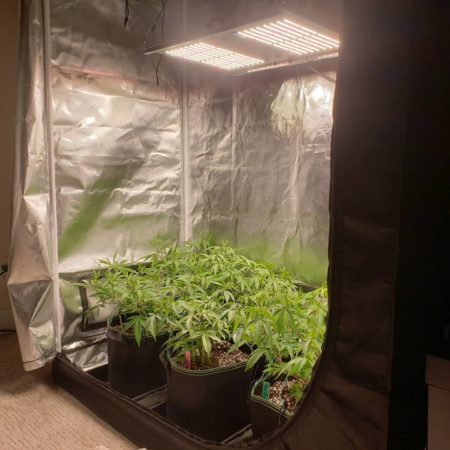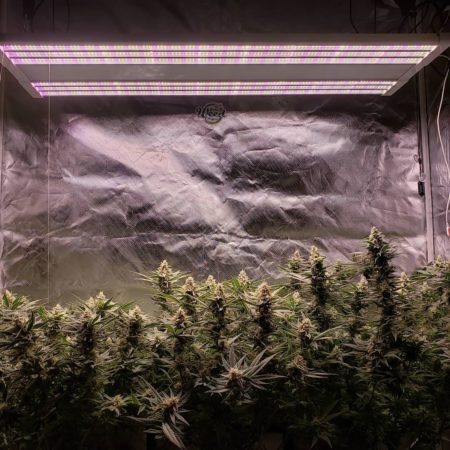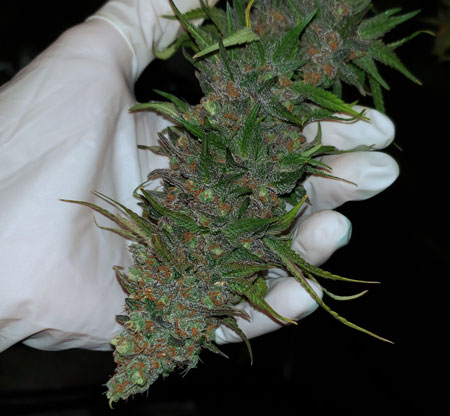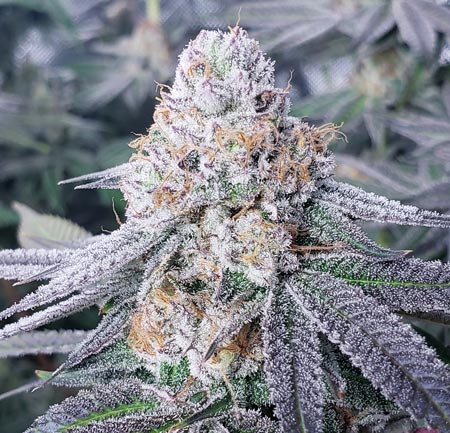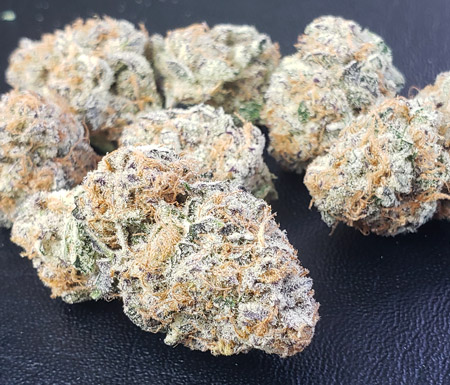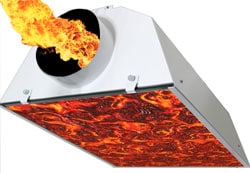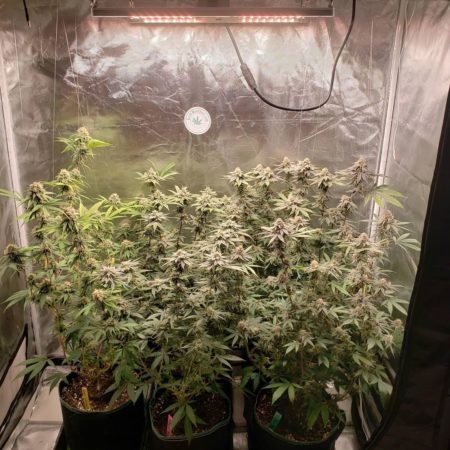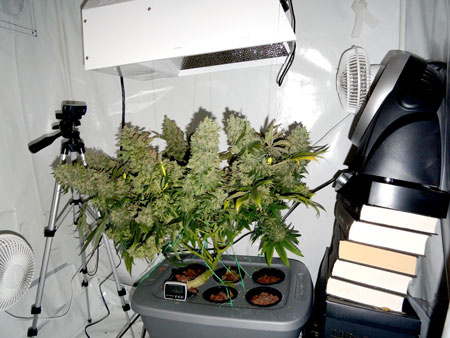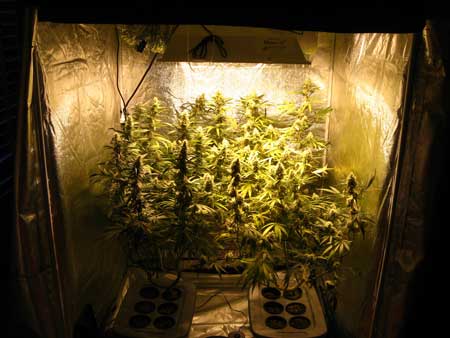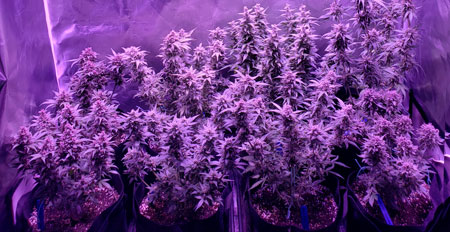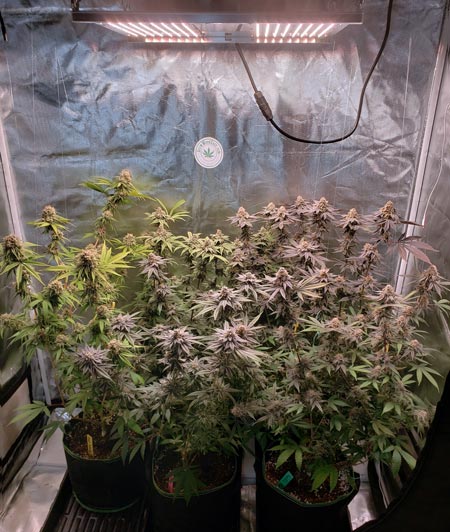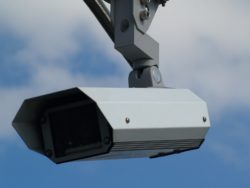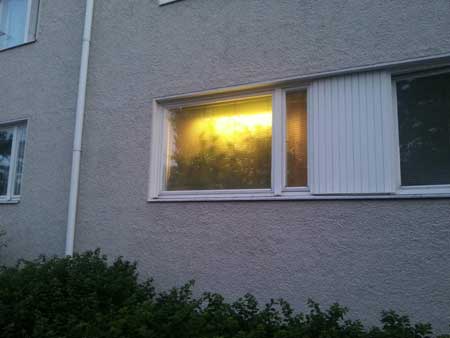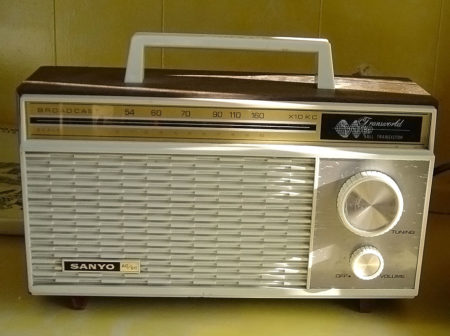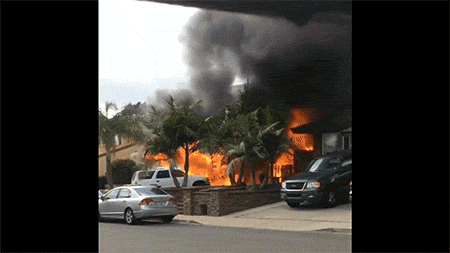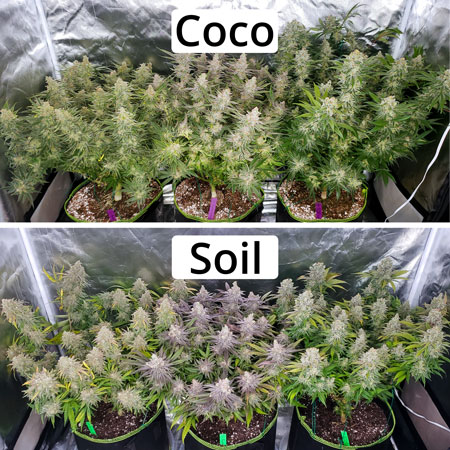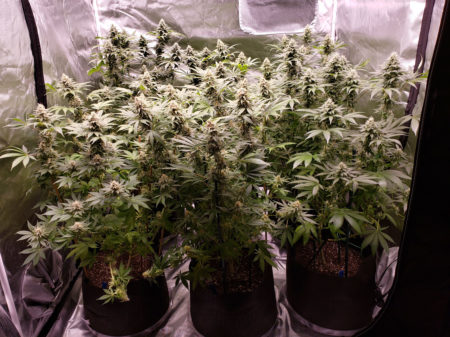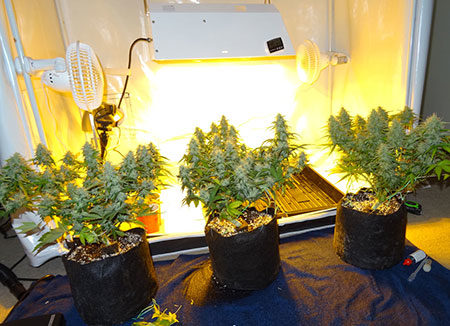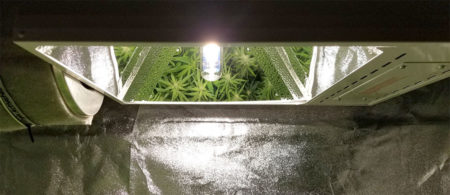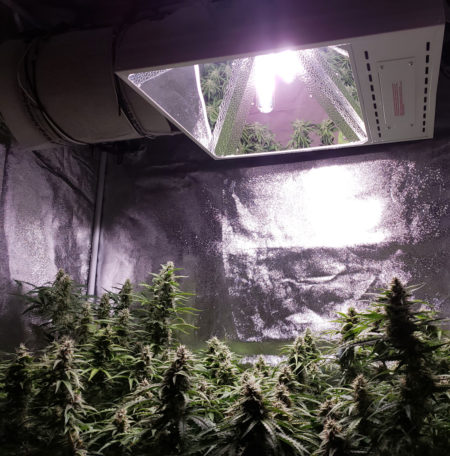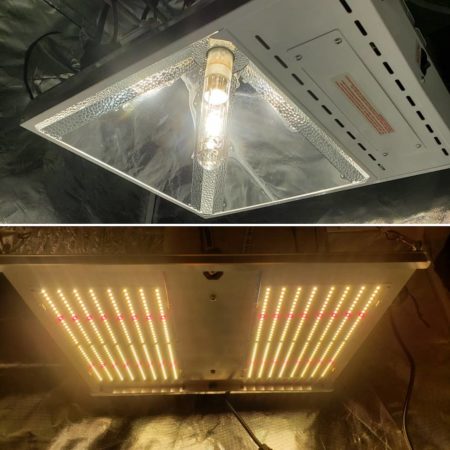Published February 13, 2021
by Nebula Haze
What is the most controversial cannabis growing topic in your opinion? For me, I’d have to say grow lights! And for many years, the two biggest competitors for top spot have been HPS and LED grow lights. [Other top growing controversies include grow medium and nutrients, followed by training techniques. Perhaps it’s not surprising the list seems to go from most to least expensive.]
There has been a years-long showdown between HPS and LED grow lights for “best grow light” for growing cannabis. Has a clear winner emerged?
History of LED Testing at GrowWeedEasy.com
At GrowWeedEasy.com, we’ve been testing LED grow lights since 2008, and until relatively recently, the LED technology just couldn’t keep up with HPS when it comes to yields and (in my opinion) bud quality. Here’s an article I wrote about the barriers to LED domination in 2015. Even though there were huge leaps in LED grow light technology from 2008 to 2015, LEDs hadn’t quite surpassed HPS yet.
But since then, the quality of cannabis growth, yields, and bud quality from LEDs has increased exponentially. In fact, the technology improvements seem to be speeding up, not slowing down. We’ve tested over a dozen LED grow lights and each LED model is better than the last. I regularly run side-by-side experimental grow journals between different grow lights, and the LEDs performed better and better until they finally surpassed HPS in tests. [Scroll to the bottom of the article to read how LEDs compare to CMH/LEC grow lights.]
Anyone who’s been following me for a while knows I’ve been a champion for HPS grow lights, so you may be surprised to hear me finally say it: modern LEDs are better than HPS for growing cannabis in most situations.
After almost 15 years of defending HPS over LEDs for growing cannabis, the field has truly changed. LED grow lights may have finally won the battle. RIP HPS.
Today I’ll share why I think LEDs have surpassed HPS as the best grow light for home growers (in most situations).
1.) Yields & Bud Quality
I’m going to start with the factor that many home growers care about the most: yields and bud quality.
When you consider the amount of electricity used, modern LED grow lights like the HLG 300 and Electric Sky 300 consistently meet or beat HPS yields in side-by-side grow experiments.
On average, the HLG 300 and Electric Sky 300 LEDs beat HPS for yields (watt for watt)
I’ve also found LED bud quality to be the same or better. LEDs often produce more colorful buds and test for higher levels of THC at the lab.
LED bud quality is the same or better (as long as you’re using good LEDs). This bud was grown under the Electric Sky 300 LED
These buds were grown under HLG 300 LEDs
However, I’ve only found this to be true for certain LED models. Older-technology LEDs like ViparSpectra produce overall lower bud quality and yields-per-watt than HPS. If you’re going to go cheap, go HPS. Don’t skimp when buying an LED!
Summary: If you invest in a good LED model, you will be rewarded with exceptional yields and bud quality that match or surpass HPS.
2.) LEDs Run Cooler (Bonus: Plants are More Heat-Resistant)
HPS grow lights are known for bringing on the heat. Their bulbs get so hot that even a quick touch can burn you. Typically you need to find some way to vent heat for any HPS over the 250W size. Ultimately, the extreme heat and intense light from an HPS bulb are out of place in the home, especially compared to a cool-running LED panel.
HPS grow lights have earned a reputation for getting hot
Although older and generic LEDs can get surprisingly hot (which always seemed strange to me since they’re marketed for being cool…), new LEDs live up to the low-heat hype.
For example, a new 300W HLG or Electric Sky 300 LED produces significantly less heat than the equivalent wattage of HPS, CMH, or fluorescent lights. New LEDs also run much cooler than older types of LED technology. For example, a high-quality 300W LED will produce significantly less heat than a crappy 300W LED grow light.
Modern LEDs don’t produce much heat per watt, and models under 300W won’t significantly raise the temperature of a room.
On top of running cooler, LEDs have another advantage for growers that struggle with heat: plants actually prefer warmer temperatures under LEDs. When growing with LEDs, plants grow best around 80°F (26°C), while plants under HPS thrive around 76°F (24°C). That means LEDs produce less heat and plants are more heat-resistant.
Summary: If heat is a challenge, LEDs are hands-down the best choice for cannabis growers.
3.) HPS Companies Stopped Serving Home Growers
HPS manufacturers used to cater to home growers and offered more sizes and options. For example, 250W HPS grow lights were once popular for home growers because they used to cost ~$120 for an all-in-one, produced relatively low heat, used only 250W of electricity, and yielded up to 10 oz of dense buds. Yet a 250W HPS is almost impossible to find anymore, and I haven’t seen an all-in-one model in years.
They don’t sell all-in-one 250W HPS grow lights for $120 anymore! I loved these things when I started growing.
If you’ve been going to hydroponic stores over the last decade, you’ve seen the popularity of various grow lights come and go. Although my local hydro store used to sell 150W, 250W, 400W, 600W, and 1000W HPS lights, they now only offer 600W. This is because the 600W size is the most electrically efficient and therefore the most profitable size for commercial growers.
Why is this happening? HPS technology is mature and HPS grow lights are cheap. Most standard HPS models can be found for under $200 and since the technology isn’t changing, customers expect the prices to go down not up. As a result, there just isn’t much profit in selling HPS lights, especially compared to LEDs which can cost $500 or more per light and take a fraction of that cost to build.
Case in point: The biggest improvement to HPS technology in the last several years is the ceramic HPS (very similar in technology to a CMH, but supposedly better for flowering) yet these are only available in 600W size, and cost an arm and a leg especially with a “specialty” ballast/hood combo. For growers looking to harvest just a few ounces at home, a 600W goes way overboard as far as heat and electricity usage.
HPS technology remains essentially unchanged for decades. Manufacturers have mostly given up trying to sell small HPS lights to hobby-scale growers. Most “new” HPS products are really just expensive variations of a 600W HPS.
Even if you do want a 600W, you often need to buy the ballast, reflector, and bulbs separately to get quality parts. The only all-in-one kits available these days are low-priced generic companies like iPower. These definitely get the job done (when they work), but they’re nothing compared to the solid high-quality HPS options that were once easy to find.
Summary: HPS grow light companies aim their products at commercial growers. If you want a grow light that’s suitable for a home environment, LEDs have more (and better) options.
4.) Convenience
One thing I absolutely love about LEDs is their convenience as far as the grower experience. Unlike HPS, LEDs can be turned on and off instantly as needed. Many models can be dimmed on the go.
My eyes are sensitive (protect your eyes under powerful lights!). I used to wear ski goggles when using high-powered lights, but now I just dim the LEDs down to 25% (or quickly turn them off) to check on plants without any discomfort or need for extra eye protection.
In comparison, once an HPS bulb is turned off, you must wait several minutes before the bulb can spark and turn on again. That means if you turn off an HPS to look at your plants, you must wait 5 minutes to turn it on again. If the electricity quickly goes off and on, your bulb will never spark properly until you notice the problem, turn it off for 5 minutes, then turn it on again. Some ballasts have an auto shut-off/turn-on feature to prevent this, but not all. What a pain.
The HPS inconvenience continues with dimming. If an HPS light is dimmable, you must turn it off first, set the dimmer, wait 5 minutes and turn it on. This all adds time and trouble compared to an LED which acts like a regular dimmable lighting fixture.
Not only that, full-spectrum LEDs usually have a whiter spectrum that allows you to see the natural color of your plants. (This obviously isn’t true for the older “blurple” LEDs). A whiter spectrum lets you take true-color plant pictures and easily monitor the health of your plants. It’s easy to miss yellowing leaves with HPS because all leaves look yellow under the harsh yellow light.
HPS grow lights make it impossible to see the actual color of your plants in person or in pictures. Yellowing or sick leaves are easy to miss under an HPS. Not only that, if you turn the HPS off so you can see your plants, you must wait several minutes before turning it back on or the bulb won’t turn on properly.
Older “blurple” LEDs have the same problem (you can’t see the real color of your plants)
However, full-spectrum LEDs let you see your plants in (mostly) full color, and can instantly be turned on or off. Many LED models also let you dim the lights while they’re still turned on.
Summary: Full-spectrum LEDs let you see your plants in full color compared to the garish yellow light of an HPS. Many LED models can be conveniently dimmed, and just about all LEDs can be turned on/off instantly. If you want to be able to easily look at plants whenever you want, LEDs are better.
5.) Security Concerns
It’s exciting that cannabis is slowly becoming legalized in many parts of the world. But even if growing is legal where you live, you may not want to advertise your plants to family, nosy neighbors, or wannabe thieves. And for many growers, there are serious legal ramifications for growing.
That means in an ideal world you want your garden to be difficult to detect. The most common way growers get busted is from a talkative third person or lack of smell control (hence the timeless security adage: “no tell, no sell, no smell”), however, HPS lights bring additional security concerns when it comes to light spectrum, RFI, and electrical safety.
HPS grow lights can be a security concern
Problem 1: HPS light color is a beacon for cops and thieves.
For many decades, most indoor cannabis plants were grown under HPS grow lights. That means that the strange yellow light from an HPS is immediately recognizable as a cannabis grow operation to law enforcement and other actors.
On the other hand, blurple LEDs look like a black light and full-spectrum LEDs (even if they’re a bit pinkish) generally look like regular lighting. LEDs aren’t nearly as suspicious if light spills out a window.
Police and potential thieves will immediately recognize weed plants are growing here from the yellow HPS light. Security fail!
Problem 2: Many HPS ballasts produce RFI (Radio Frequency Interference)
Many HPS ballasts produce RFI that can be detected from miles away. Not only that, the RFI scrambles the sound of an AM radio. That means anyone who happens to use an AM radio in the area will get major interference every time your lights turn on. I’ve heard of a case where someone tracked down and reported a cannabis grower because he couldn’t listen to the radio whenever the HPS turns on. We use an AM radio to test each HPS ballast we use, but who wants to worry about that?
If your HPS ballast produces RFI, anyone using an AM radio within miles of your home will know the moment your lights turn on because it will scramble their programming.
Problem 3: HPS grow lights can be a fire hazard
This is about security but even more so about safety. HPS lights use a ballast, and few to none are FCC compliant or UL listed. Their ballasts are rarely tested and cleared for safety. A grower once wrote in that his HPS ballast had FCC Compliant stickers, but he realized the stickers were fake. This is not to say that all or even most LEDs are tested for safety, but HPS is a bigger potential fire hazard because they get hotter and produce more concentrated heat.
A malfunctioning HPS grow light can start a fire (make sure to protect your grow room from fires!)
Summary: HPS grow lights aren’t the best option for stealth and security.
Conclusion: LEDs are better for (most) home growers
LED Grow Lights are Awesome – LEDs are the best grow light for dealing with heat. They offer many options aimed at home growers, with a variety of form factors and sizes to support any available grow space. Excellent yields and exceptional bud quality, especially from the newer models.
This Pineapple Chunk plant was grown under an HLG 65 and yielded about 3 ounces. Not bad for a 65W LED!
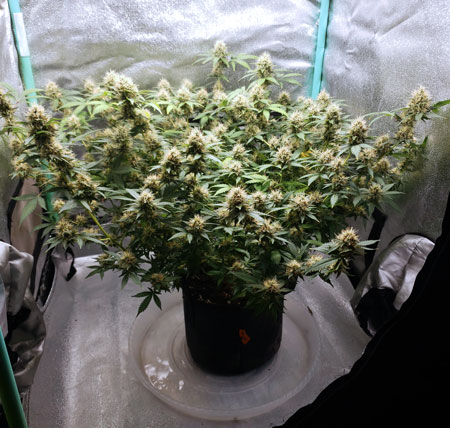
2 x Electric Sky 300s (for a total of 600W) yielded well over a pound!
HPS is better in some situations – HPS is better than LEDs when it’s cold because they run hotter yet plants can handle cooler temperatures. Plants under LEDs grow slowly in the cold, while plants under HPS will still grow fast even when the temperature drops. If you’re struggling with cold in the grow room, HPS may be a better choice. I often use an HPS or CMH for my winter grows so I don’t have to run a heater in the grow room.
HPS can be a great choice if your grow space gets cold
What about LEDs vs CMH grow lights (LECs)?
This article focuses on LEDs vs HPS, but what about CMH grow lights? Since I’ve also tested this extensively, I figured I’d share my thoughts while you’re here.
CMH stands for “Ceramic Metal Halide”. CMH is also commonly referred to as LEC for “Light Emitting Ceramic”.
What is a CMH? CMH stands for Ceramic Metal Halide and the technology was invented in 1962. It’s essentially a hybrid between a Metal Halide and HPS grow light (it’s a Metal Halide that uses ceramic like an HPS). When I first started growing in 2008, CMH was often sold alongside MH and HPS. It was available in the same sizes, for a similar price, and many ballasts could actually support all 3 types of bulbs. You can still find those if you look in the right places.
However, CMH technology was rebranded several years ago under the name “LEC” by the company Sun System, and the cost more than doubled for these “new” fixtures. I personally believe Sun System was trying to make CMH seem like a new type of light like LEDs even though CMH technology was already half a century old. These new versions come in 315W and 630W sizes which can no longer be mixed and matched with MH or HPS bulbs. The new versions need specialized ballasts and unique bulbs (with an annoying bulb socket locking mechanism vs the previous standard mogul bulb socket that twists in like any other bulb).
CMH grow lights produce great results, especially when paired with the Phillips 4200k CMH bulb!
Despite the questionable marketing and lame new bulb socket design, CMHs are excellent cannabis grow lights that provide significant differences and some improvements over HPS. I have had great results with CMH and although they do get hot, I recommend them for growers who aren’t worried about heat and want to try something different. I’ve been able to yield over a pound with a 315W CMH grow light in one grow, and bud quality is excellent.
But how does CMH compare to LEDs?
- CMH runs much hotter than LEDs per watt, so they’re not the best choice if you’re struggling with heat
- Plants tend to grow significantly faster in the vegetative stage with CMH than LEDs (in fact, I’ve consistently had the fastest vegetative growth with CMH compared to any other light type)
- Plants tend to grow taller and more stretchy under CMH than LEDs
- Buds tend to be slightly lower in potency (about 0.5-1% lower THC levels in lab tests) compared to clones grown in identical conditions under HLG or Electric Sky LEDs
CMH on top, LED on bottom
In my side-by-side tests so far, the bulb makes a huge difference to results with CMH…
When flowering with the Phillips 4200k bulb (blue)
- Insane trichome production – Buds (and surrounding leaves) are more sparkly with this bulb compared to any other grow light including LEDs or HPS
- Stronger smell – When clones are grown side-by-side, CMH consistently produces higher levels of terpenes in lab tests than LEDs or HPS
- Good Yields – Comparable to LEDs or HPS
When flowering with the Philips 3100k bulb (more red)
- Incredible Yields – Better than LEDs or HPS. This bulb produces some of the best yields-per-watt.
- Lower bud quality – Unfortunately, bud quality is not as good under the 3100k bulb compared to buds grown under the 4200k bulb or LEDs
I personally have had better results with the Philips bulbs than the biggest bulb competitor, Eye Hortilux. Those are the only 3 CMH bulbs I’ve used for flowering so far, but there are many more. Contact us and let us know your experience with other brands of CMH bulbs!
Summary for LEDs vs CMH:
CMH is a better choice than LEDs if you are dealing with cold temperatures (like in winter), but avoid CMH if heat is a concern.
CMH with the Phillips 4200k bulb is the best grow light (in my experience) for trichome and terpene production. Even if you take clones of the same plant, the ones flowered under the 4200k CMH bulb produce more trichomes and test for higher levels of terpenes than the clone grown in identical conditions under LED or HPS. That means CMH with the Philips 4200k bulb may be the best grow light for extractions. If you plan on using your buds to make hash or other extractions, this light can increase the yields and terpene levels of your extracts.

